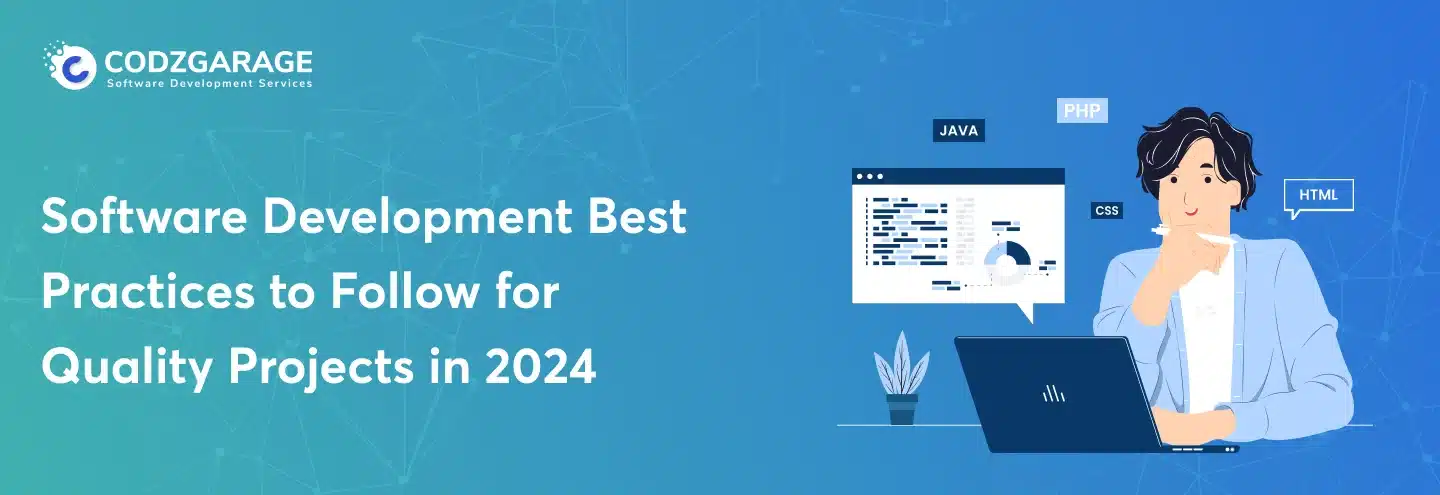-
583
Software Maintenance Life Cycle: A Detailed Guide for 2023-24
Software maintenance is a process that involves activities like making changes, modifications, and upgrading the software, intending to decomplexify it for enhanced performance and user experience.
Do you, too, think once the software gets developed and deployed, you’re all set and will be enjoying its benefits forever while sitting on your hands? If yes, then you’re completely wrong! Your need to perform constant software maintenance to have it performed as expected! However, the maintenance cycle is endless; let’s learn how to manage it!
Irrespective of how efficiently software is built, there’ll always be a space for enhancement. As time passes by, your business scales, and so do its necessities. That’s why you need to maintain your software to keep it aligned with the current business environment.
However, it’s crucial there’s no end to the software maintenance, and this is because there’s no software out there with perfection. You have to constantly upgrade and update your software to keep it in alignment to ensure it meets your constantly growing requirements.
Codzgarage is a reputed custom software development companyprovides end to end software development and modernization solutions, putting an end to the hassle you encounter. Contact us, to get a free consultation!
Since maintaining software is a never-ending process, it may be way more complex for you. Hence, you better have a strategic plan to execute the software maintenance process. Let’s learn how to manage this ever-evolving procedure with ease and convenience!
Let’s dig deeper!
What Is Software Maintenance?
Software maintenance is one of the significant processes, or you can say a crucial element of the software development life cycle. It gets started after the development is completed and the software is deployed. The preliminary intent of maintaining software is to make sure it performs well and remains aligned with the constantly increasing or changing requirements of the marketplace. For this you need to know best practices for legacy software modernization so that you maintain your system effectively.
In short, software maintenance is the practice that consists of continuously upgrading a software product intending to fix bugs and add necessary elements and features to improve its performance and bring it in alignment with the current business requirements. Maintaining software not only makes the software perform flawlessly but also enhances the user’s experience, improving better opportunities for growth.
What’s the Importance of Software Maintenance?
There are plenty of reasons why software requires maintenance. There are many like feature enhancement, cloud migration, and many others that can be the reason for maintaining software. Regardless of the reason, if your software requires maintenance, you mustn’t take it lightly— as it may bring you at the risk of losing efficiency or, in the worst-case scenario, your customers, too.
You may choose software maintenance as per your industry requirements. For example, the manufacturing sector mostly opts for these five maintenance types. According to Statista, “Preventive maintenance program is the most commonly deployed maintenance strategy” within the manufacturing sector. In 2021, 88% of businesses dealing in manufacturing used preventive maintenance strategies.
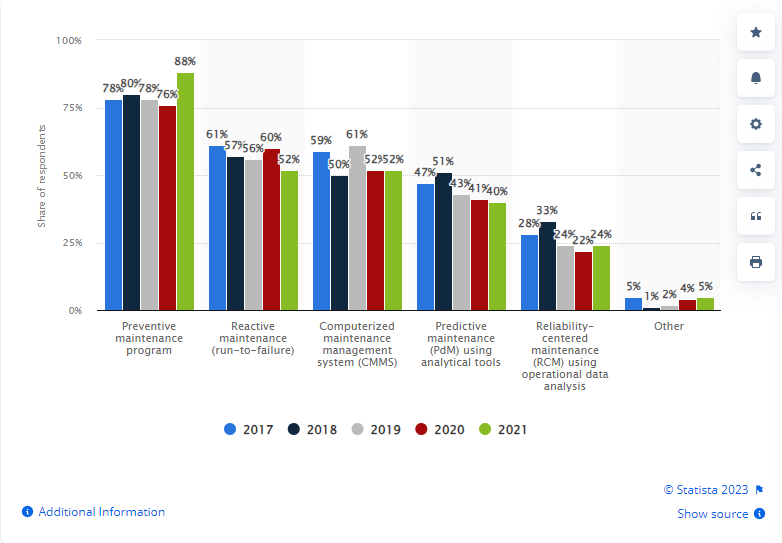
Drawbacks If Software Maintenance Ignored
Have a look at the examples of how obsolete software can let your business down!
- Legacy software would cause a great level of disruption in the process when functions with heavy tech debt. Hence, you need to maintain it following the best legacy software modernization practices.
- An instant messaging application will possibly get outdated when one of its competitors provides a better version of that of theirs. AOL Messanger, iChat, or MSN Messenger are some examples of software that went outclassed just because they failed to keep in alignment with the current market demands.
- Except these all, a company is more likely to come across inefficiencies in its sales management system when the hardware isn’t in alignment with the new features.
Benefits of Software Maintenance
When you perform software maintenance on time, you circumvent the possibility of encountering such scenarios and run your business efficiently. Let’s explore in detail why you should keep your software maintained!
Excellent Performance and Efficiency
Software having obsolete functionalities accumulates tech debt and causes a mitigated system’s efficiency. Furthermore, it makes the software rigid and tough to be updated. When you follow the software maintenance process, you replace those obsolete features and coding elements with new and trending functionalities so that the software can conveniently adapt to the current industry trends and remain no longer affected by tech debt.
Accelerated Project Continuity
Your IT infrastructure and other systems must be functioning optimally for your project’s continuity. Any disruption in this may cause the processes and productivity of your organization to suffer. With maintenance, you can make sure the software, as well as the operations, won’t be affected by unexpected circumstances.
No matter whether it’s your server going down or a sudden hike in user requests when you perform software maintenance, you equip your system to deal with any issues like this and keep the project going with no interruption.
Robust Data Security
Robust security is another reason why you need software maintenance. It makes bug fixing, reengineering data, and encoding constraints way easier while keeping the system from being vulnerable to security concerns.
Furthermore, maintaining your software is crucial to deal with hacking attacks. Hackers, in general, find it handy to hack an older application; hence, maintaining your system with the latest features and functionalities enhances its robustness against these vulnerabilities, making your data more secure.
The Software Maintenance Process Life Cycle
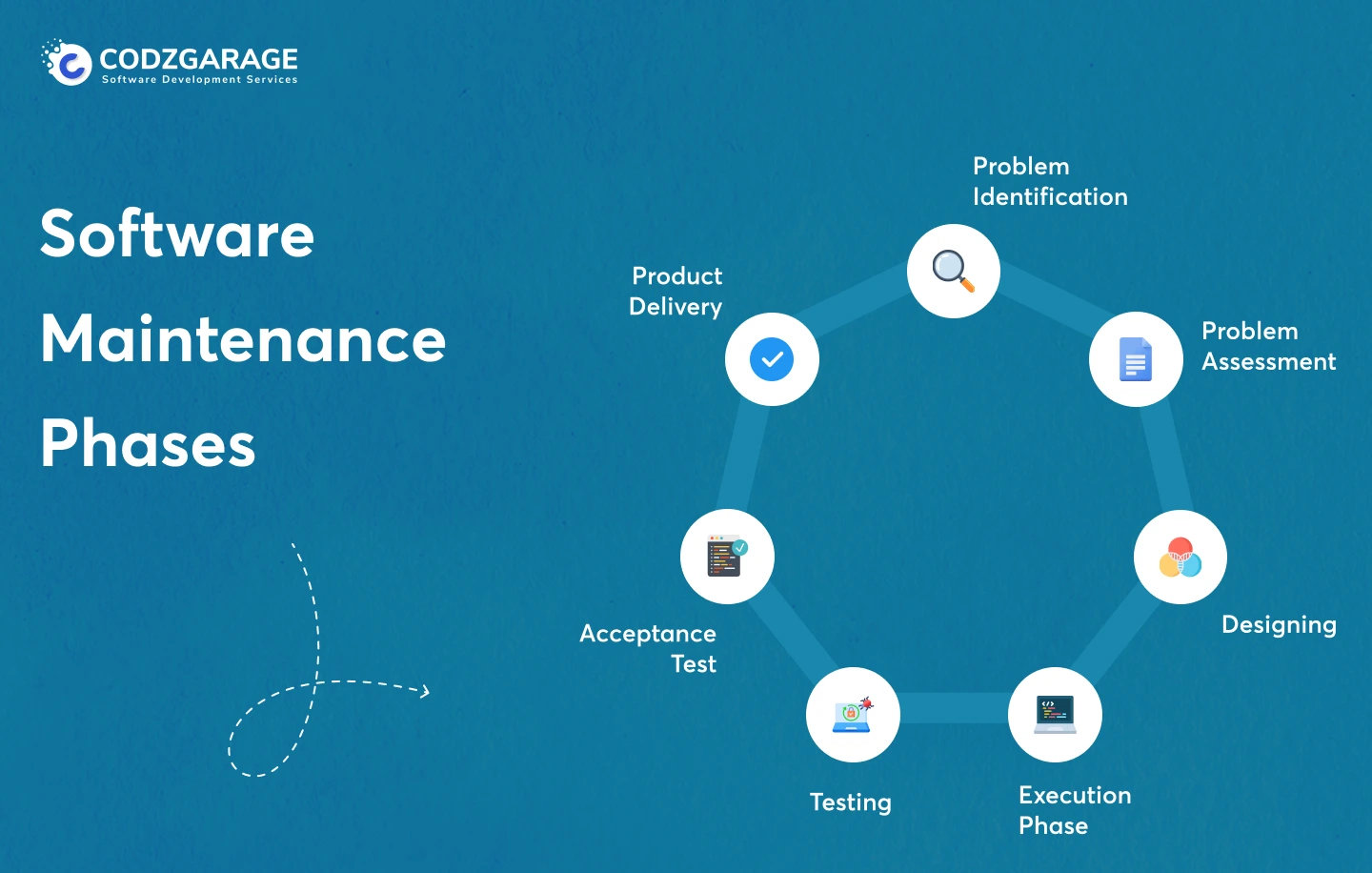
Software maintenance is an integral part of software development life cycle (SDLC). Like SDLC, it’s a constant process that occurs after building software that involves bug fixes, optimization, and deletion of discarded features and optimizing the existing ones. Here are the phases of this lifecycle that you should have a look at!
Problem Identification
This is the preliminary phase of the software maintenance process that involves the identification of the problems in the software. In this phase, the team of dexterous engineers analyzes the modification request to ascertain the certain areas that require modification and assign modification numbers to each.
After that, developers examine the modification request so that they can determine the type of software maintenance. The type of maintenance can be of any type, including corrective, adaptive, preventive, or perfective. Then, the developers prioritize each modification request to ensure creating an order following which it will proceed.
Problem Assessment
Problem assessment is the second phase of the software maintenance life cycle. This phase determines the possibility and scope of each validated modification request. In the problem assessment phase, the developers plan every possible change to be made in the software. They do it based on the validated modification requests, the initial resources, project documentation, and repository information.
Designing
The next phase we have is called the design phase. In the design phase, developers create a module that consists of the things in need of replacement and modification. Furthermore, they create test cases that address the safety and security aspects to validate and verify the system.
The design phase includes multiple activities, including modification of the software modules, documentation, revising the modification list, creating test cases for new designs, creating regression tests, and so on.
Execution Phase
The implementation, or execution phase, is where the developers make modifications to the code, add specifications, integrate new features, and modify the whole software from the get-go. Here, the input attribute comprises the design phase output, source code, modified system, and project documentation.
Testing
Now, we have the testing phase in which the development or testing team conducts integration testing of the system and new modules. The preliminary intention for conducting this testing is to make sure no new bug is introduced in the software once it gets modified during the software maintenance process.
Eventually, developers test the whole system inside out by performing regressive testing. The developers, once done, can create test reports and reviews and the updated software documentation.
Acceptance Test
After testing, the acceptance test comes into play wherein the internal users, along with third parties, specify and test the integrated system. The key purpose of this testing is to verify and ensure the new integrated features and functionalities work in the way expected or mentioned in the modification requests.
Product Delivery
Once the acceptance testing gets done successfully, the product delivery takes place. In the product delivery phase, the team of developers working on the project delivers updated software to the client. Besides, they provide extensive documentation containing manuals and files that describe the software operation manual and hardware specifications.
The Types of Software Maintenance
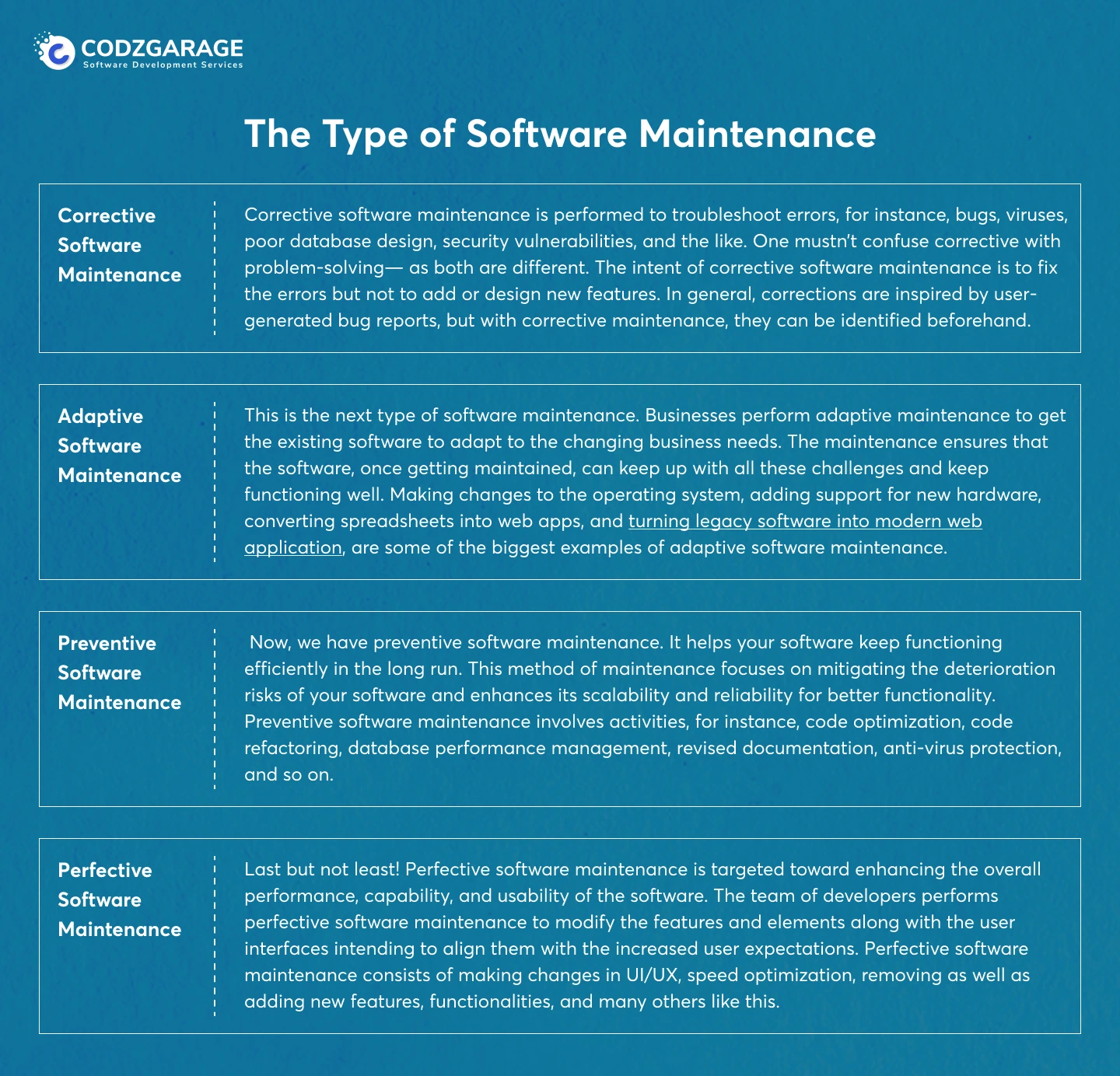
- Corrective Software Maintenance— Corrective software maintenance is performed to troubleshoot errors, for instance, bugs, viruses, poor database design, security vulnerabilities, and the like. One mustn’t confuse corrective with problem-solving— as both are different. The intent of corrective software maintenance is to fix the errors but not to add or design new features. In general, corrections are inspired by user-generated bug reports, but with corrective maintenance, they can be identified beforehand.
- Adaptive Software Maintenance— This is the next type of software maintenance. Businesses perform adaptive maintenance to get the existing software to adapt to the changing business needs. The maintenance ensures that the software, once getting maintained, can keep up with all these challenges and keep functioning well. Making changes to the operating system, adding support for new hardware, converting spreadsheets into web apps, and turning legacy software into modern web application, are some of the biggest examples of adaptive software maintenance.
- Preventive Software Maintenance— Now, we have preventive software maintenance. It helps your software keep functioning efficiently in the long run. This method of maintenance focuses on mitigating the deterioration risks of your software and enhances its scalability and reliability for better functionality. Preventive software maintenance involves activities, for instance, code optimization, code refactoring, database performance management, revised documentation, anti-virus protection, and so on.
- Perfective Software Maintenance— Last but not least! Perfective software maintenance is targeted toward enhancing the overall performance, capability, and usability of the software. The team of developers performs perfective software maintenance to modify the features and elements along with the user interfaces intending to align them with the increased user expectations. Perfective software maintenance consists of making changes in UI/UX, speed optimization, removing as well as adding new features, functionalities, and many others like this.
Best Practices for Effective Software Maintenance
The plan for software maintenance should be created based on a business’s specific needs. Below mentioned are some tips you should know to get help when creating a software maintenance plan that brings optimized success.
- Keep Your Plan Simple— Complex plans are likely to be forgotten and ignored; hence, try to keep all the steps involved in software maintenance clear and concise. The simpler the plan, the easier it is to execute, enhancing the chances of getting succeeded.
- Keep Team Members in the Know About Your Plan— To plan is good, but it won’t have any influence on your project until it gets implemented. Therefore, make sure you keep your team members in the know about the plan you have created. The members include developers, testers, clients, and the like.
- Create a Schedule— Creating a schedule assists you in being assured that everyone working on a project is aware of the time of each task to be done.
- Stick to the Schedule— Just creating a schedule won’t come in handy when you don’t stick to it. Therefore, it’s essential to stick to the schedule you’ve made as much as possible. Following this schedule assures you that everyone working on the project is aware of each of the steps required and it’s getting done in the right way.
- Keep Records— You should keep records of the steps taken toward software maintenance. It enables you to keep track of your project’s progress and recognize the specific areas that are in need of improvement.
- Use Checklists— Making use of checklists is of utmost significance. It ensures that all the steps are getting followed properly during each phase of maintenance. Furthermore, they assist you in tracking the progress and ascertaining any kind of issue that may arise.
Conclusion
That’s all there’s to it! While software development is something that brings your ideas to life, maintenance is what keeps it alive in the marketplace. As time passes by, your business scale and the requirements change. This includes not only your business requirements but also your customer’s requirements.
Therefore, software maintenance becomes unavoidable to maintain so that you can bridge the gap. It keeps your software bug free and updated and enhances data security, resilience, and the overall performance of your existing system. Moreover, it helps you keep tech debt at bay.
In this article, we discussed software maintenance, its importance, the types of software maintenance, along with the software maintenance life cycle. If you’re in need of software maintenance, we’re a custom software development company providing core software maintenance services to businesses across the globe to get their requirements extinguished. Connect with us to leverage the benefits.
Want to
hire fullstack developers?Developers’ attributes:
- Accomplished developers
- A Decade of experience
- Dexterity in profession
- Quality solutions



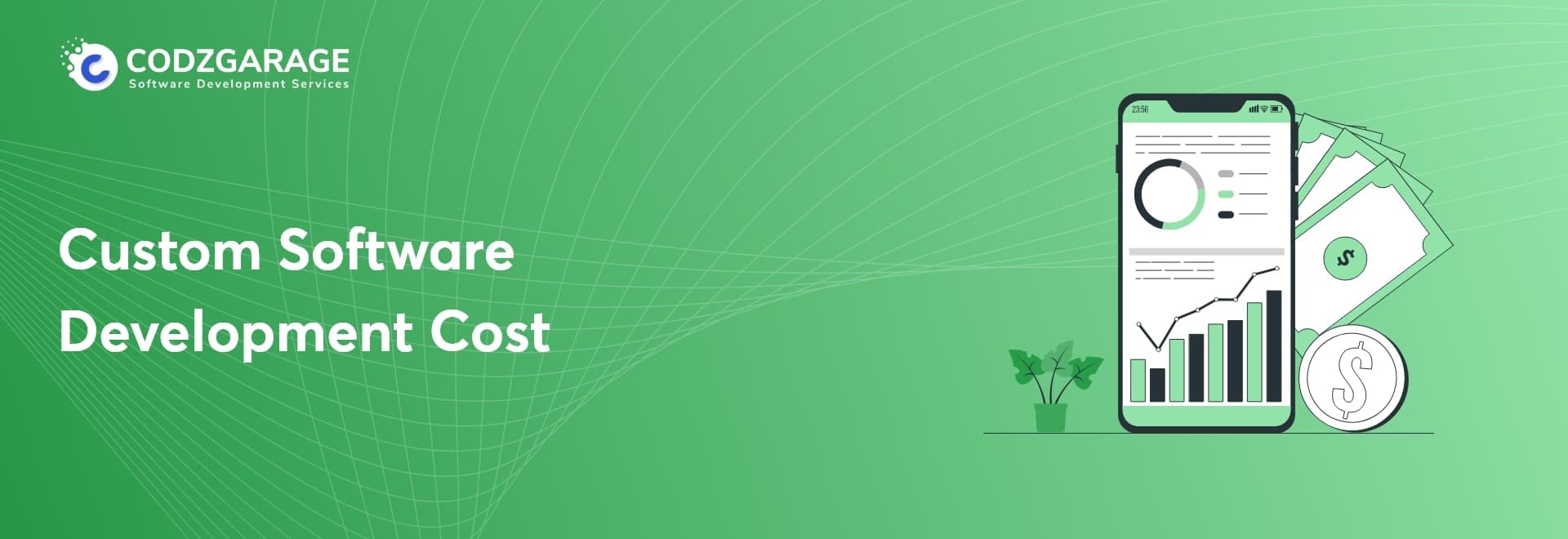
 Kevin Bhut
Kevin Bhut 

